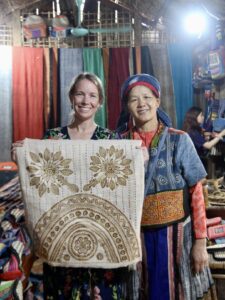Unravelling the Traditional Hmong Linen-Making Process
The traditional Hmong linen-making craft process comprises 18 steps, from harvesting the flax plant to the finished product.A Heritage From Ha Giang Province
The origins of Hmong linen-making trace back to the 19th century in Ha Giang Province, Vietnam, with roots in China.A Tapestry of Cultural Identity
Hmong linen-making is deeply intertwined with the cultural identity and survival of the Hmong people, who originate from the mountainous regions of China, Laos, Vietnam, and Thailand. For centuries, they have crafted linen from hemp, a tradition handed down through generations.Crafting Linen with Care
Historically semi-nomadic, the Hmong inhabited isolated, mountainous areas where flax plants flourished. They meticulously cultivated, harvested, and processed flax fibres to produce linen. This involved soaking, fibre removal, spinning, and hand-weaving.Threads of Meaning
The complex designs and vibrant patterns in Hmong textiles transcend mere decoration, carrying profound cultural and spiritual significance. Reflecting themes from nature, folklore, and daily life, these designs preserve the group’s history and stories that Hmong females proudly present these days.Self-Sufficiency and Craftsmanship
Living in remote areas required self-sufficiency and strong craftsmanship skills. This led to the creation of the linen-making tradition craft. Hmong linen-making displays resilience and adaptability, hence becoming a source of cultural pride and identity without being affected by the war and migration locally.
Preservation of Cultural Heritage
 Hmong linen-making is a practical craft and a vital cultural practice. It has helped maintain the Vietnamese community’s heritage through changing times and environments. Linen served not only as clothing but also as ceremonial attire, symbolizing social status and heritage.
Hmong linen-making is a practical craft and a vital cultural practice. It has helped maintain the Vietnamese community’s heritage through changing times and environments. Linen served not only as clothing but also as ceremonial attire, symbolizing social status and heritage.